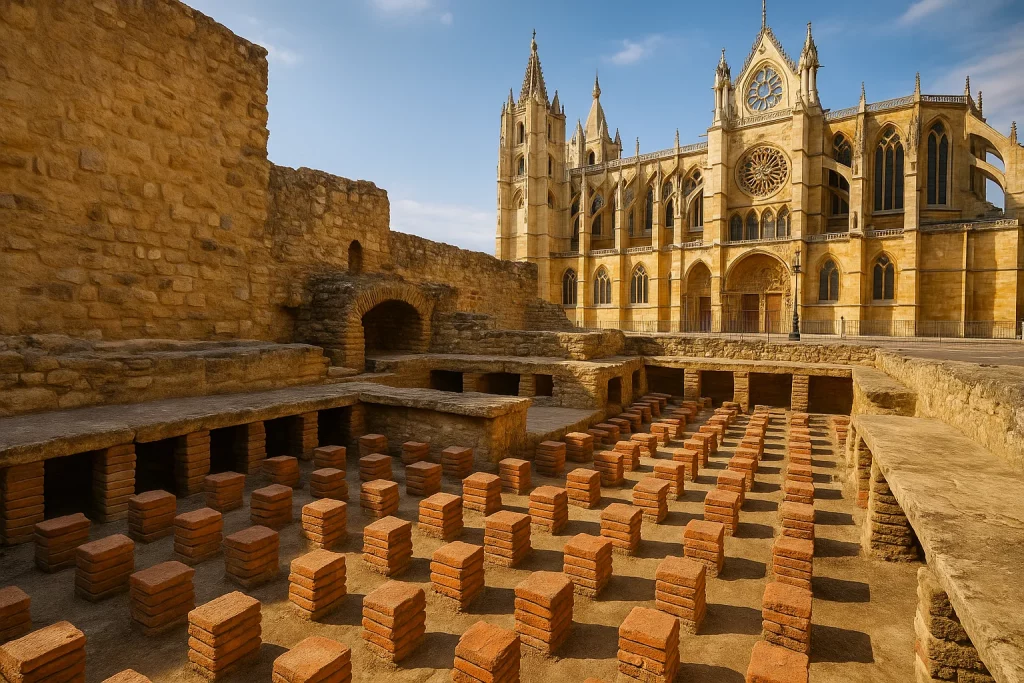Few visitors to León realise that beneath its busiest streets lies a fascinating Roman legacy. León’s Roman baths take us back to the military camp of the Legio VII Gemina, revealing how leisure, hygiene and sociability coexisted alongside formidable structures.
This underground heritage is unique because it remained hidden for centuries, protected by the medieval and modern buildings constructed above it. Today, thanks to archaeology, we can walk through spaces that were once essential to legionary life and see first-hand the sophistication of Roman engineering.

León: city of legions and Roman baths
In the 1st century AD, the Legio VI Victrix and later the Legio VII Gemina established a camp that evolved into a city. As part of military urbanism, public baths were built with rooms at different temperatures, hypocaust-heated floors, and social areas for soldiers. These baths were both practical and social, connected to the camp’s hydraulic network.
Their design followed an imperial standard: cold rooms (frigidarium), warm rooms (tepidarium), and hot rooms (caldarium), as well as training and rest areas. This balance of hygiene, exercise and social life explains why the baths were the heart of any Roman city.
Puerta Obispo Archaeological Crypt
The gateway to the past is the Puerta Obispo Archaeological Crypt, by the south side of the Cathedral. Here you can see original walls and floors, remains of the heating system, and part of the Porta Principalis Sinistra, one of the camp’s monumental gates. Visits are free, and regular opening hours (Tuesday–Saturday 11:00–14:00 and 17:00–20:00; Sundays and holidays 11:00–14:00; closed on Mondays) are published on the official website.
A visit to the crypt not only reveals the baths; it also helps you grasp the scale of the camp and its links with the rest of Roman León. On-site explanations and lighting highlight architectural details that would otherwise go unnoticed.
Roman León Interpretation Centre
To understand this heritage in context, start at the Roman León Interpretation Centre, housed in the Casona de Puerta Castillo. You’ll find models, panels and archaeological pieces that reconstruct the story of Roman León and its urban layout. Entry is free.
The centre also connects the history of the baths with other Roman remains in León, such as the walls, the amphitheatre and paved streets—giving visitors a complete picture of how life in the camp was organised.
A little-known historic gem
These underground baths are still relatively unknown beyond the local public, offering an authentic, unhurried experience. They’re perfect to combine with a visit to the Cathedral or a stroll through the old town, and they provide a fresh perspective on León’s heritage—without the crowds of other monuments.
Because they’re less publicised than other highlights, visiting them adds a touch of exclusivity—ideal for cultural travellers keen to discover “the León not everyone sees.”
Suggested itinerary
- Start at the Roman León Interpretation Centre.
- Walk the historic centre following Roman traces (look for caligae footprints set into the pavement).
- Finish at the Puerta Obispo Crypt, descending to the baths area.
- Round off the route with other camp remains at Plaza del Cid or Plaza de San Isidoro.
This itinerary lets you move chronologically—from interpreted history to tangible history—ending with real Roman stone under your feet.
🛏 Your ideal base in León
Make the most of your visit by staying in the heart of the city. At León Apartamentos, we offer modern, comfortable stays just steps from the Crypt, the Cathedral and the Interpretation Centre—the perfect balance of history and rest.
📌 Book now: https://leonapartamentos.com
Being so close means you can improvise your visit according to the weather or your mood, without long journeys.

